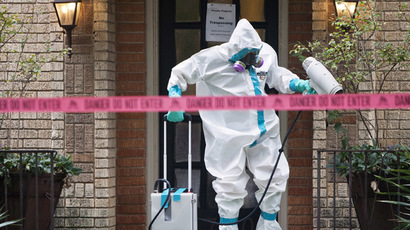70-90% efficiency: Russia to send Ebola vaccine to W. Africa in 2 months

In two months, Russia is planning to send a new experimental vaccine against Ebola to Africa, according to the country’s health minister. The efficiency of the drug, which is to be tested on the ground, is about 70-90 percent.
“Today we are discussing that we will have enough of Triazoverin vaccine in two months so that we can send them to our personnel in Guinea and test its efficiency in clinical conditions,” Health Minister Veronika Skvortsova said.
The vaccine has so far proved efficient against various hemorrhagic fevers, including the Marburg virus which is very similar to Ebola.
“The efficiency ranges between 70 and 90 percent and this is a very good indicator,” Skvortsova said.
Russia’ Virology Institute is preparing a whole group of drugs.
“They are basically genetically engineered drugs which can work both for disease treatment and prevention,” Skvortsova said.
Russian virologists, who have set up a laboratory in Guinea, are preparing to test the vaccine on primates.
“The vaccine we have produced is made from the attenuated strains [of the virus]. We now have enough to repeat the experiment on the primates and proceed to clinical trials.”
READ MORE: Scientists in Russia developing three Ebola vaccines
On Sunday, Skvortsova announced that Russian scientists are working on three potential Ebola vaccines which they expect to introduce as soon as in the next six months.
"We have created three vaccines,” she said in an interview with Rossiya-1 TV. “One vaccine is based on a strain of Ebola, and the other two have been created by means of genetic engineering.”
As of October 8, a total of 4,033 people had died from the Ebola outbreak, out of a total of 8,399 registered cases in seven countries, the World Health Organization (WHO) reported. For now, Liberia is the worst-hit with 4,076 cases and 2,316 deaths. It is followed by Sierra Leone, where there are 2,950 cases and 930 deaths.
According to the WHO, the fatality rate associated with Ebola averages roughly 50 percent, but has ranged from 25 percent to 90 percent in past outbreaks.














